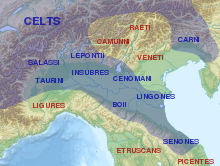Senones

The Senones or Senonii (
Part of the Senones settled in the Italian peninsula, where they ousted the Umbrians between Ariminum (modern-day Rimini) and Ancona. They are described in classical sources[citation needed] as the leaders of the Gallic war-band that captured Rome during the Battle of the Allia in 390 BC. They remained a constant threat until Rome eventually subjugated them in 283 BC, after which they disappeared from Italy.[1]
Name
They are mentioned as Sḗnōnes (Σήνωνες) and Sḗnōnas (Σήνωνας) by Polybius (2nd c. BC),[2] Senonii by Caesar (mid-1st c. BC),[3] Sénnōnes (Σέννωνες) by Diodorus Siculus (1st c. BC),[4] Sénōnes (Σένωνες) by Strabo (early 1st c. AD),[5] Senones by Pliny (1st c. AD),[6] Sénones (Σένονες) by Ptolemy (2nd c. AD),[7] and as Senones by Ammnianus (4th c. AD).[8][9]
The
The city of Sens, attested in the 4th century AD as Senonas oppidum ('oppidum of the Senones'), is named after the Gallic tribe.[14]
Geography
The Senones of Gauls dwelled around their capital Agedincum (present-day Sens).[14]
History


In Gallia Cisalpina
They joined Bellovesus's migrations towards Italy ca. 600 BC, together with the Aeduii, Ambarri, Arverni, Aulerci, and Carnutes.[15]
In 400 BC, they crossed the Alps and invaded Italy as far as Rome which they plundered. They retreated and, driving out the
For more than 100 years the Senones were engaged in
It is possible that they joined with Gallic tribes who spread themselves throughout the lands of the Danube, Macedonia, and Asia Minor. Sena Gallica (currently Senigallia) was made a Roman colony, named to distinguish it from Sena Julia (Siena) in Etruria.[16]
In Gallia Transalpina
A branch of the Senones (or a different tribe of the same name) settling the district which now includes the departments of
Culture
Their contact with the Italic populations and the strong Etruscan influences created a two-way cultural osmosis indicating some integration with the native populations, sometimes by mixed marriages; for example the progressive Hellenisation of the Senones with the adoption of typical practices of the Italians such as the consumption of wine and the rite of the symposium, and the appearance of typical Celtic artefacts such as swords and scabbards of the La Tène type in the Picene necropolises of Numana, Arcevia, Camerano and San Filippo di Osimo. Their presence in the Piceno area including the early period immediately after the defeat of the Senones and their allies is shown by tomb contents particularly funerary costumes, while the settlements have not been excavated.
References
- ^ Salmon & Potter 2016.
- ^ Polybius. Historíai, 2:17:7, 19:10, 20:1, 21:7.
- ^ Caesar. Commentarii de Bello Gallico, 2:2.
- ^ Diodorus Siculus. Bibliotheca historica, 14:113:3.
- ^ Strabo. Geōgraphiká, 4:3:5.
- ^ Pliny. Naturalis Historia, 4:107.
- ^ Ptolemy. Geōgraphikḕ Hyphḗgēsis, 2:8:9.
- ^ Ammianus Marcellinus. Res Gestae, 15:11:11.
- ^ Falileyev 2010, s.v. Senones.
- ^ Delamarre 2003, p. 270.
- ^ Matasović 2009, p. 330.
- ^ Lambert 1994, p. 34.
- ^ Lambert 2005, s.v. Σένονες.
- ^ a b Nègre 1990, p. 157.
- Ab Urbe condita5.34-35.3.
- ^ a b c One or more of the preceding sentences incorporates text from a publication now in the public domain: Chisholm, Hugh, ed. (1911). "Senones". Encyclopædia Britannica. Vol. 24 (11th ed.). Cambridge University Press. pp. 647–648.
- ^ Polybius, Histories 2: 19: 7-10).
- ^ Paulus Orosius, History against the Pagans’, 3: 22
- ^ Polybius, Gallic Wars, 2.13
Bibliography
- ISBN 9782877723695.
- Falileyev, Alexander (2010). Dictionary of Continental Celtic Place-names: A Celtic Companion to the Barrington Atlas of the Greek and Roman World. CMCS. ISBN 978-0955718236.
- ISBN 978-2-87772-089-2.
- ISBN 978-8478825721.
- Matasović, Ranko (2009). Etymological Dictionary of Proto-Celtic. Brill. ISBN 978-90-04-17336-1.
- ISBN 978-2-600-02883-7.
- Salmon, Edward T.; Potter, T. W. (2016), "Senones", Oxford Research Encyclopedia of Classics, Oxford University Press, ISBN 978-0-19-938113-5
External links
- Harris, W., R. Talbert, T. Elliott, S. Gillies (30 August 2022). "Places: 413311 (Senones)". Pleiades. Retrieved February 29, 2012.
{{cite web}}: CS1 maint: multiple names: authors list (link)

